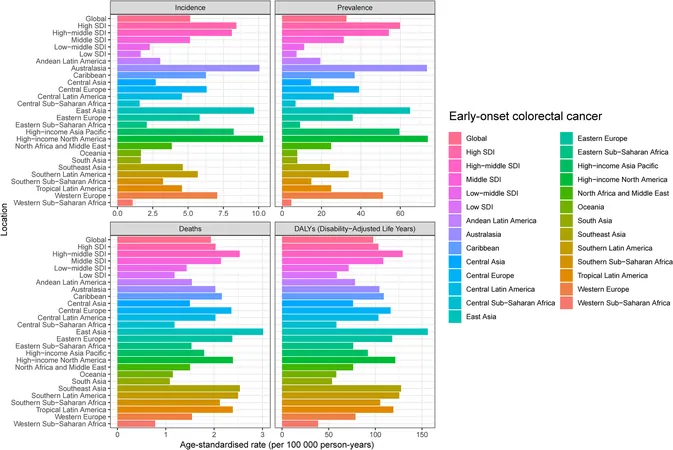
The Rising Tide of Colorectal Cancer: Unpacking Global Trends and Projections Through 2040
2025-07-01
Author: Daniel
Understanding the Burden of Colorectal Cancer
A groundbreaking study reveals alarming trends in colorectal cancer (CRC) incidence and mortality from 1990 to 2021, with eye-opening projections through 2040. Both early-onset (EOCRC) and late-onset (LOCRC) forms are climbing, underscoring a global health crisis that demands urgent attention.
The Alarming Statistics
Globally, the number of early-onset colorectal cancer cases has nearly doubled, jumping from 107,300 cases in 1990 to a staggering 211,900 in 2021. Meanwhile, late-onset cases soared from 809,300 to nearly 2 million within the same timeframe. This surge is accompanied by a complex picture of mortality rates—while deaths from EOCRC increased from 59,200 to 79,500, LOCRC deaths skyrocketed to an astonishing 964,600.
Diving Deeper: Regional Disparities
The impacts of EOCRC are unevenly distributed. East Asia bears the highest burden, with 81,700 incident cases and over 547,000 prevalent cases reported in 2021. Meanwhile, high-income regions like North America demonstrate the highest age-standardized incidence rates for EOCRC. Central Latin America is experiencing the fastest increases across all metrics.
What's Driving These Trends?
Risk factors are pivotal in this rise. Unhealthy diets—characterized by low fiber and high red meat intake—have emerged as major culprits. Additionally, lifestyle factors such as smoking and obesity significantly contribute to the increasing burden of CRC. Urgently needed are targeted prevention strategies, particularly for younger demographics.
Projections: A Grim Forecast
Looking ahead to 2040, situations are expected to worsen if current trends persist. The projection estimates nearly 270,000 new EOCRC cases and over 3.3 million LOCRC cases, marking an era where early-onset cases could surpass 12% of all cases, a stark reminder of the need for effective screening and prevention measures.
Taking Action: What Can Be Done?
To combat this rising tide, health authorities must prioritize early screening and health education, particularly in high-risk populations. Issues such as genetic predisposition should be addressed alongside lifestyle alterations to curb these alarming trends.
Conclusion: A Call to Arms
The evidence is clear and indubitable: Colorectal cancer, both early-onset and late-onset, is escalating at an unsustainable rate. Urgent, coordinated action is required on both local and global fronts to mitigate this looming health crisis and protect future generations.

 Brasil (PT)
Brasil (PT)
 Canada (EN)
Canada (EN)
 Chile (ES)
Chile (ES)
 Česko (CS)
Česko (CS)
 대한민국 (KO)
대한민국 (KO)
 España (ES)
España (ES)
 France (FR)
France (FR)
 Hong Kong (EN)
Hong Kong (EN)
 Italia (IT)
Italia (IT)
 日本 (JA)
日本 (JA)
 Magyarország (HU)
Magyarország (HU)
 Norge (NO)
Norge (NO)
 Polska (PL)
Polska (PL)
 Schweiz (DE)
Schweiz (DE)
 Singapore (EN)
Singapore (EN)
 Sverige (SV)
Sverige (SV)
 Suomi (FI)
Suomi (FI)
 Türkiye (TR)
Türkiye (TR)
 الإمارات العربية المتحدة (AR)
الإمارات العربية المتحدة (AR)